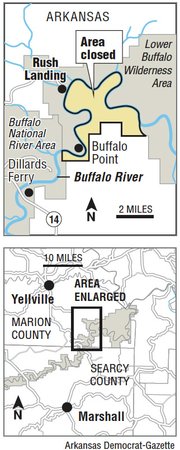A 200-acre wildfire was burning Monday in the Lower Buffalo Wilderness of Marion County.
Firefighters contained the blaze, which is in a section known as the "duckhead," late Sunday and waited for it to burn itself out, said Caven Clark, a spokesman for the Buffalo National River.
"Because there's no human life or property assets as risk -- no buildings at risk -- we'd rather deal with it by just letting it take care of itself," Clark said.
Wildfires occurred in at least 22 Arkansas counties over the weekend, scorching more than 500 acres, said Adriane Barnes, a spokesman for the Arkansas Forestry Commission. That included a 160-acre fire in north Pulaski County and a 100-acre fire in Faulkner County, both on Sunday. Barnes said her numbers don't include state parks or federal lands.
A 2,687-acre section of the Lower Buffalo Wilderness remains closed until that fire is under control. The river is open, but visitors should use the north side for any camping or other activities in the area, Clark said.
"No threats are anticipated, but it could be very smoky at times," he said. "One of the reasons they're not aggressively suppressing it is because it is rough country. This is not an area you can drive into and drop a bulldozer blade down."
The river meanders north in the area, forming the shape of a duck's head when looking at a map. Rush Landing is on the river near the top of the "duckhead."
Firefighters created a half-mile-long firebreak between the two closest points on the river -- basically, what would be the duck's neck -- to isolate the duckhead and keep the fire from spreading south. The river will contain the fire within the rest of the duckhead, Clark said.
Clark said the fire was "kind of jumping from ridge top to ridge top," and four separate areas were ablaze Monday within the containment zone.
Work Monday centered on strengthening the containment line and burning "fuel" between the separate fires. Most of the fuel consisted of very dry leaf litter, but it also included limbs from a 2009 ice storm, Clark said.
"They've had fires in this area in the past, and they've used this same containment area," he said.
When the fire started Sunday, winds were about 15 mph, with gusts up to 20 mph, Clark said. "It's enough to move a fire pretty good."
The fire increased in size from about 20 acres late Sunday to 200 acres Monday morning, but still air on Monday helped calm the blaze, Clark said.
"The fire will stay in place and burn itself out if conditions remain the same," he said.
Slowly burning out
By Monday, most of the fires on forestry commission land had been extinguished, Barnes said.
Increased humidity and slightly lower temperatures helped keep the fires from spreading, she said.
Barnes said 40 acres burned Monday in Columbia, Conway, Grant, Hempstead and Howard counties.
"These have all since been put out in entirety and remained relatively small in size," she said.
By midafternoon Monday, Barnes said, small fires were still being contained in Columbia, Grant, Greene, Newton, Saline, Union and Washington counties.
Barnes said a series of fires in Saline County on Saturday were apparently caused by a motorist who was driving a pickup that had a metal chain dragging behind it. Friction with the pavement caused sparks that ignited dry grass on the side of the road.
Small fires -- each about a quarter-acre in size -- were contained Monday at Mount Nebo State Park and on U.S. Forest Service land near Mount Magazine.
The Forest Service worked five fires over the weekend, said Tracy Farley, a spokesman for the Ouachita and Ozark-St. Francis National Forests. The largest one, at 243 acres, was in Oklahoma. While most of the 1.8-million-acre Ouachita National Forest is in Arkansas, part of it stretches into southeastern Oklahoma.
Forest Service firefighters assisted with the fire on the Buffalo River.
On Mount Nebo
Joe Jacobs, a spokesman for Arkansas State Parks, said the fire on Mount Nebo was one of about 20 small fires in the Yell County area Monday. He said it was handled by the Mount Nebo Rural Fire Department and the Dardanelle Rural Fire Department.
Clark said the unseasonably warm January temperatures have people heading for parks, but they need to exercise caution because fires spread quickly when grass and leaves are dry. Clark said people need to be especially careful when burning leaves or trash.
The Arkansas Forestry Commission reported 1,240 documented wildfires in 2014, burning 16,867 acres of land. More than one-third of those fires took place on nonforested land, according to the commission.
March is usually the peak of Arkansas' wildfire season, according to the commission.
Metro on 01/20/2015
